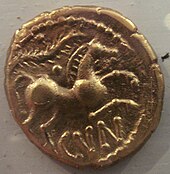Celtic coinage
Celtic coinage was minted by the Celts from the late 4th century BC to the mid 1st century AD. Celtic coins were influenced by trade with and the supply of mercenaries to the Greeks, and initially copied Greek designs, especially Macedonian coins from the time of Philip II of Macedon and his son, Alexander the Great. [1][2][3] Thus Greek motifs and even letters can be found on various Celtic coins, especially those of southern France.[4]
Gaulish coinage


Greek coinage occurred in three Greek cities of Massalia, Emporiae and Rhoda, and was copied throughout southern Gaul.[2]
Northern Gaulish coins were especially influenced by the coinage of Philip II of Macedon and his famous son Alexander the Great.[2] Celtic coins often retained Greek subjects, such as the head of Apollo on the obverse and two-horse chariot on the reverse of the gold stater of Philip II, but developed their own style from that basis, allowing for the development of a Graeco-Celtic synthesis.[2]
After this first period in which Celtic coins rather faithfully reproduced Greek types, designs started to become more symbolic, as exemplified by the coinage of the Parisii in the Belgic region of northern France.[2]
The Armorican Celtic style in northwestern Gaul also developed from Celtic designs from the Rhine valley, themselves derived from earlier Greek prototypes such as the wine scroll and split palmette.[2]


The Boii gave their name to Bohemia and Bologna; a Celtic coin (Biatec) from Bratislava's mint is displayed on Slovak 5 koruna coin, which was in use until Slovakia joined the euro zone on January 1, 2009.
The images found on Celtic coins include giants trailing severed heads on rope, horsemen charging into battle, gods and goddesses, skulls and chariot wheels, thunderbolts and lightning, the sun and the moon. They are miniature masterpieces of surreal art.[citation needed]
A tribe of Celts called Eburones minted gold coins with triple spirals (a Celtic good luck symbol) on the front, and horses on the back.[5]
The coins were either 'struck' or 'cast'. Both methods required a substantial degree of knowledge. Striking a blank coin formed in a clay mould was one way. After forming the blank, it would have been flattened out before striking with a die made from iron or bronze. The tiny details engraved on dies were just a few millimeters in diameter. Casting a coin required a different technique. They were produced by pouring molten alloy into a set of molds which were broken apart when the metal had cooled.
With the Roman invasion of Gaul, Greek-inspired Celtic coinage started to incorporate Roman influence instead, until it disappeared to be completely replaced by Roman coinage.[2]
British Celtic coinage


Traditional historians have tended to overlook the role played by Celtic coinage in the early history of British money.[6]
Over 45,000 of the ancient British and Gaulish coins discovered in Britain have been recorded at the Oxford Celtic Coin Index.[7][8] The Trinovantian tribal oppidum of Camulodunon (modern Colchester) was minting large numbers of coins in the first centuries BC and AD, which have been found across Southern Britain.[9] Common motifs on the Camulodunon coins included horses and wheat/barley sheafs,[10] with the names of the rulers written mostly in Latin script, and more rarely in Greek.[10]
Notes
- ^ a b Boardman, p.308
- ^ a b c d e f g Celtic culture: a historical encyclopedia" John T. Koch p.461-
- ^ School of Archaeology, University of Oxford "Coinage in Celtic society". Archived from the original on July 16, 2008. Retrieved August 10, 2008.
- ^ Celtic Inscriptions on Gaulish and British Coins" by Beale Poste p.135 [1]
- ^ Cache of Celtic Coins Uncovered in Dutch Cornfield Archived 2012-10-21 at the Wayback Machine Associated Press November 16, 2008
- ^ Davies, Glyn. A history of money from ancient times to the present day, 3rd ed. Cardiff: University of Wales Press, 2002. 720 pages. Paperback: ISBN 0-7083-1717-0. Hardback: ISBN 0-7083-1773-1.
- ^ "Archived copy". Archived from the original on 2011-05-16. Retrieved 2010-12-20.
{{cite web}}: CS1 maint: archived copy as title (link) The Oxford Celtic Coin Index - ^ "Archived copy". Archived from the original on 2012-06-29. Retrieved 2012-06-30.
{{cite web}}: CS1 maint: archived copy as title (link) The Oxford Celtic Coin Index - ^ Crummy, Philip (1997) City of Victory; the story of Colchester - Britain's first Roman town. Published by Colchester Archaeological Trust (ISBN 1 897719 04 3)
- ^ a b Crummy, Philip (1987) The Coins as Dating Evidence. In Crummy, N. (ed.) Colchester Archaeological Report 4: The Coins from Excavations in Colchester 1971-9. Published by Colchester Archaeological Trust
References
- Boardman, John The Diffusion of Classical Art in Antiquity, Princeton 1993 ISBN 0-691-03680-2



